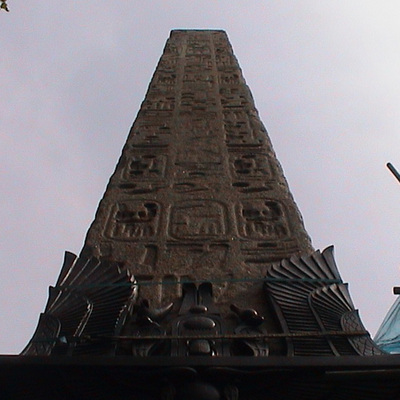The scars that disfigure the pedestal of the obelisk, the bases of the sphinxes, and the right hand sphinx, were caused by fragments of a bomb dropped in the roadway close to this spot, in the first raid on London by German aeroplanes a few minutes before midnight on Tuesday 4th September 1917.
Londonist have a eye-witness account of this event.
Site: Cleopatra's needle (3 memorials)
WC2, Victoria Embankment
A misnomer since there is no connection with Cleopatra at all. In 1500 BC Pharaoh Thothmes erected two red granite obelisks at Heliopolis. The Romans took them to Alexandria in 12 BC where an earthquake brought them down. In 1819, following Nelson's victory at the Battle of the Nile, Britain was presented with this (near-buried) obelisk by the Viceroy of Egypt. It was not until 1877 that funds had been raised for shipment to London, which involved building a pontoon barge around the stone.
The 'Cleopatra' was not a lucky ship; it was holed and sunk during the launch. Salvaged, it was then almost lost in the Bay of Biscay in a storm when the barge broke loose from the towing steamer, the 'Olga'. 6 members of the Olga crew died as they tried to board the Cleopatra to bring it under control. But eventually it reached London and the obelisk was erected on a plinth containing a time capsule from that era. Its mate was given to the States and erected in Central Park, New York in 1881. The Cleopatra's needle in Place de la Concorde, Paris is also one of a pair but its mate is still in situ in Luxor.
2020: Reviewing a book on archaeology Tom Holland wrote "The shipping of obelisks to Paris, London and New York provided a brutally castratory metaphor for the way in which scholars from distant lands took ownership of the study of Egypt's past."
March 2024: We were contacted by Christian Falvey, in connection with a scavenger hunt he was trying to solve. He drew our attention to small brass plaques in front of the Sphinx benches along the Victoria Embankment. We had not previously spotted the plaques and so could not assist Christian with his quest.
Memoirs of a Metro Girl has a very informative post about the benches. There are two designs for the end panels: those on benches near Cleopatra’s Needle incorporate sphinxes; the others incorporate camels.
The benches were restored in 2008 and it’s probable that the plaques record the organisations that funded this, and earlier restorations. We have not yet photographed them but Christian has kindly forwarded one photo and a list of 14 plaques in front of benches with sphinx panels, as follows:
The Savoy
Queen’s Silver Jubilee, 1977, donated by Shell U. K. Limited (transcribed from the photo)
The Institute of Electrical Engineers
Lloyds of London
Sir Gerald Glover
The Strand Association
W.H. Smith & Son
The Bahamas
The Royal Institute of chartered Surveyors
British Gas
Thelma Seear
The House of Commons
Gerry Cottle's Circus
Debenhams
We have a note to research these plaques when next in the area, and meanwhile wish Christian luck with future scavenger hunts.












Comments are provided by Facebook, please ensure you are signed in here to see them